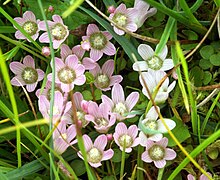| Bog pimpernel | |
|---|---|
 | |
| Scientific classification | |
| Kingdom: | Plantae |
| Clade: | Tracheophytes |
| Clade: | Angiosperms |
| Clade: | Eudicots |
| Clade: | Asterids |
| Order: | Ericales |
| Family: | Primulaceae |
| Genus: | Anagallis |
| Species: | A. tenella |
| Binomial name | |
| Anagallis tenella (L.) L. | |
Anagallis tenella, known in Britain as the bog pimpernel, [1] is a low growing perennial plant found in a variety of damp habitats from calcareous dune slacks to boggy and peaty heaths in western and southern Europe and Northwest Africa. [2] In the United Kingdom it is mostly restricted to the western half of the country, although it was more common in the east before land drainage and intensification of farming in that area. [3]
Traditionally included in the family Primulaceae, the genus Anagallis was considered to be better placed within the related family Myrsinaceae. [4] In the APG III system, Primulaceae is expanded to include Myrsinacae, thus Anagallis is now in Primulaceae again.
In England this plant is a component of the Purple moor grass and rush pastures BAP habitat.